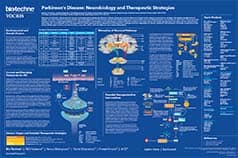Ubiquitin/Proteasome System
The Ubiquitin/Proteasome System (UPS) is a highly regulated mechanism of intracellular protein degradation and turnover. Through the concerted actions of a series of enzymes, proteins are marked for proteasomal degradation by being linked to the polypeptide co-factor, ubiquitin. The UPS participates in a wide array of biological functions such as antigen presentation, regulation of gene transcription and the cell cycle, and activation of NF-κB.
Ubiquitin/Proteasome System Target Files
Ubiquitination
Ubiquitin (Ub) is a polypeptide, 76 amino acids in length, which acts as a molecular label within the UPS. Each Ub polypeptide has seven lysine residues; these are involved in linking multiple Ub polypeptides together to form a polyubiquitin chain. The pattern and distribution of ubiquitination determines the final fate of a protein. For example, monoubiquitination has been linked to endocytosis, protein sorting, nuclear export of proteins, DNA repair and transcription regulation, whilst polyubiquitination signals protein degradation, DNA repair, kinase activation and transcription factor activation.
The process by which proteins are ubiquitinated comprises three main steps:
- Activation of Ub at its C-terminus by an E1 ubiquitin-activating enzyme
- Conjugation of Ub to an E2 ubiquitin-conjugating enzyme
- Transfer of Ub to the substrate protein by an E3 ubiquitin ligase
Protein targets of the UPS include regulators of cell cycle and apoptosis, transcription factors involved in the regulation of cell division, growth, differentiation, signal transduction and response to stress, and therefore the UPS is linked to a multitude of cellular processes. As an example, the UPS components MDM2 and Cullin 3, both E3 ligases, are key regulators of the DNA damage response and the Nrf2 pathway respectively, preventing the inappropriate activation of cellular stress responses.
Dysregulation of the UPS has been linked to a wide variety of diseases, including neurological disorders, cancer and atherosclerosis. Its function is of particular interest in protein-misfolding disorders such as Parkinson's disease and Huntington's disease, where aberrant UPS activity is thought to contribute to the intracellular accumulation of toxic proteins.
Ubiquitin-independent Proteasomal Degradation
Though ubiquitination is one of the main mechanisms for initiating proteasomal degradation of a target protein, emerging evidence suggests that proteins may also be degraded via ubiquitin-independent mechanisms. An example of this is the ubiquitin-independent degradation of topoisomerase IIβ following its persistent interference with RNA polymerase II activity.
Literature for Ubiquitin/Proteasome System
Tocris offers the following scientific literature for Ubiquitin/Proteasome System to showcase our products. We invite you to request* your copy today!
*Please note that Tocris will only send literature to established scientific business / institute addresses.
Huntington's Disease Research Product Guide
This product guide provides a background to Huntington's disease research and lists around 100 products for the study of:
- Somatic Instability
- Proteolysis and Inclusion Bodies
- Transcriptional Dysregulation
- Mitochondrial Dysfunction
- Nuclear-Cytoplasmic Transport Interference
- Excitotoxicity
- Stem Cells
Parkinson's Disease Poster
Parkinson's disease (PD) causes chronic disability and is the second most common neurodegenerative condition. This poster outlines the neurobiology of the disease, as well as highlighting current therapeutic treatments for symptomatic PD, and emerging therapeutic strategies to delay PD onset and progression.



